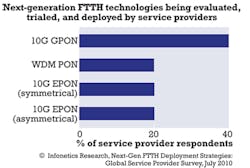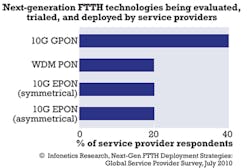As FTTH requirements continue to evolve, flexibility becomes more of a requirement than a luxury in systems design.
By Per Lembre
The rapid pace at which fiber and Carrier Ethernet technologies are being deployed is changing broadband network build strategies. As demand for advanced services, such as video on demand and HDTV, continues to grow, the traditional copper-based infrastructure will need to be replaced with a modern, fiber-based infrastructure ready to deliver these services. In the process, service providers, system vendors, and chip suppliers will need to work closely together to optimize cost and develop sound business models that reflect our always-on society.
New access infrastructure remains a multi-billion dollar investment; therefore, extending the life of the active network components by even a few years can reap tremendous benefits and reduce business risk for service providers. So what's the best way to accomplish this goal–to create a new infrastructure that can improve return on investment (ROI) and deliver better, faster services at competitive price points?
Asset lifetime extension
Service providers have extensive requirements for their next-generation fiber access networks. They want architectures and systems that accommodate growth, new advancements, and evolving standards. Physical rights of way, ducts, and fiber deployments in the first mile and second mile require a long-term business model, in which depreciation can be measured in decades rather than years. Yet, the technical lifetime of active access equipment in many access deployments runs a mere five to seven years.
Can this equipment be designed to meet telco's depreciation expectations? System vendors bear a huge responsibility for the life-cycle characteristics of current broadband technologies. For example, when defining a new product, they may have a certain service provider access deploy-ment in mind. This approach tends to drastically narrow the requirements to a "must list" for winning that one deal.
Such a practice often sacrifices head-room for future growth and feature enhancements. The fiber access system vendor market is, therefore, rather fragmented, with many players serving domestic markets only. This trend is in contrast to the IP/MPLS switching and services market, where the competitive balance among regions is even more apparent among global players.
Systems developers can overcome such shortcomings and extend the lifetime of their systems to better meet carrier business models by meeting two fundamental requirements. First, the product must have free capacity and processing headroom to accommodate new services. Second, the data plane must be upgradable–that is, it must be programmable.
These two characteristics enable the use of software upgrades to enhance feature sets over time. This ability reduces the risk that a platform will not be able to evolve with changing service provider requirements. Vendors can add new features by revising the data plane or by taking a more flexible approach that aligns product development and hard market requirements. Extending the lifetime of products by just three years will greatly improve the business case for the next-generation access infrastructure.
Making the hardware call
New access switches and optical line terminals (OLTs) designed to address the global market will need to support point-to-point and point-to-multipoint Ethernet in their full range of technical flavors: GPON, EPON, 10GEPON, and XGPON (see Figure 1). Broadband traffic processing will be logically divided between the PON MAC/controller for adaptation to the access line, and the packet processing device for managing a common set of demarcation services and traffic management features that ensure correct forwarding and shaping to enforce fine-grained user policies. Such a division enables the vendor to develop a common set of access services and apply them to a range of access types.
So, what hardware options do system vendors have to implement these packet processing features? Let's first take a look back. Lower-speed, copper-based, last-mile system implementations often used DSL access-optimized programmable network processor units (NPUs). The programmability of these devices had a profound effect on the success of DSL, by far the most popular broadband technology in the world to date. Programmable processing enabled streamlined operations and maintenance of customer premises equipment. It also supported simplified interoperability among vendors and continued innovation and upgrades without hardware disruption.
Present OLT and access switch designs for the fiber access market differ from their copper predecessors in many respects. First generations were developed using hardware meant for an enterprise Ethernet switch environment. High-bandwidth and Ethernet capabilities were obvious advantages. Lack of security and manageability were obvious disadvantages. With more than 10 years of evolution, there are many more options available to match the requirements of next-generation fiber access infrastructure. Programmable packet processing can be preserved as the industry moves to higher bandwidth and greater features.
System vendors have three main choices for the chips at the core of their next-generation fiber access platforms:
- Fixed-function Ethernet switches
- Field-programmable gate arrays (FPGAs)
- Programmable Ethernet switches
Fixed-function Ethernet switches:
Fixed-function Ethernet switches can speed initial product development by enabling system vendors to configure forwarding and operations, administration, and maintenance (OAM) functions. However, they do not provide the flexibility to adapt to evolving standards. This drawback ultimately limits the lifetime of the product. In addition, it is hard to differentiate products and systems based on such devices, so they tend to compete on price rather than on new features and adaptability to service provider requirements. This circumstance significantly affects the addressable market for the product and limits the system vendor's support of the service provider's future roll-out plans.
FPGAs: FPGAs are generic devices that can be programmed to behave as packet processing devices with configurable functions. They serve a huge market, and the latest generations are quite powerful. The drawbacks with FPGA-based packet processors begin with meeting the required price and power budgets for access systems, as they scale from today's 10 Gbps per line card to 40 Gbps per line card. Another challenge is the implementation of traffic management features for buffering packets and shaping user traffic to defined service-level agreements (SLAs). And while FPGAs are programmable, it is a rather complex engineering task to design, validate, and test a data plane implementation on these devices.
Programmable Ethernet switches: Programmable Ethernet switches offer an attractive alternative to these approaches. They are based on network processing technology optimized for access equipment. These switches can extend the lifetime of access platforms and provide the ability to handle diverse and continually evolving customer requirements. Programmability allows system vendors to introduce new services to the market more quickly. System vendors also can rapidly develop access platforms that offer the performance, scalability, and adaptability service providers require in long-term infrastructure deployments.
Service providers in Japan and China, for example, regularly use evolving PON standards as the baseline for product specifications and deployment discussions with their system suppliers. To separately accommodate these individual product requirements using an in-house ASIC or fixed-function Ethernet switch would create tremendous risk and implementation time barriers. The integration of programmable packet processing devices, and more specifically, programmable Ethernet switches, is a truly viable alternative.
Meeting differences in global demand
FTTx technology has a long road ahead before it achieves dominant status among broadband connectivity options. At the same time, current market conditions represent huge growth opportunities for the networking industry as a whole. We see major broadband network initiatives in almost every region across the globe, but through entirely different methods and at different speeds.
The star example of this story is Asia, which outpaces all other regions in the adoption of fiber access. Heavy Reading estimates that approximately 85 million households will be directly connected to fiber by the end of 2013 ("FTTH Review & Five-Year Forecast: The Road to Next-Gen PON," July 2009). Japan, Korea, and China are leading the charge in providing fiber access to its residents. Japan, for example, has 18 million ports–
representing two-thirds of all broadband lines in the country. Amazingly enough, this progress pales in comparison to the efforts being made in China. China has now overtaken Japan as the world's largest FTTX market with 24 million subscribers.
While the European and American markets have not reached the level of maturity of its Asian counterparts, there is still significant growth. Each region of the world has taken a slightly different approach to the broadband process. In Japan, NTT East and NTT West have deployed an FTTH network using EPON/GPON technology. European deployments to date have been largely dominated by municipal, utility, and competitive telcos. The European Commission has now published a regulation on Next Generation Access (NGA) that mandates incumbents to provide competitors access to multi-fiber, technology-neutral infrastructure.
In the United States, competition between cable multiple systems operators and telcos continues to drive the fiber market. We see many different approaches, with Verizon using GPON and AT&T selecting a fiber-to-the-node approach with VDSL2 used for customer connections. And Google has announced trials that could use Gigabit Ethernet point-to-point access. While these approaches spur the adoption of fiber in some areas, it will ultimately leave some regions in the U.S. without access to fiber. This market gap will hopefully fuel innovation that results in alternative and creative approaches to bringing FTTH to underserved cities and regions.
Fragmentation in the access market, therefore, appears to be a fact of life. To serve a global customer base, system vendors will need to use hardware that is flexible enough to adapt to various regional contexts.
Never stop innovating
While we do not know the exact path the transition to fiber access will take worldwide, there is no doubt that users will significantly benefit from the next generation of access infrastructure. There will be more bandwidth offered at compelling price points.
For the players in the broadband infrastructure value chain, there are many business opportunities ahead, paired with heavy investments and significant risk. Looking ahead, there are first mover advantages and clusters of innovation in Asia that the rest of the world can leverage.
Programmability will be a core element in enabling system vendors to develop future-proof technologies that offer the performance, scalability, and adaptability service providers require in long-term infrastructure deployments.
Programmable Ethernet switches provide the ability to adapt platforms to fine-grainedPER LEMBRE is director of product marketing at communications semiconductor vendor Xelerated.


